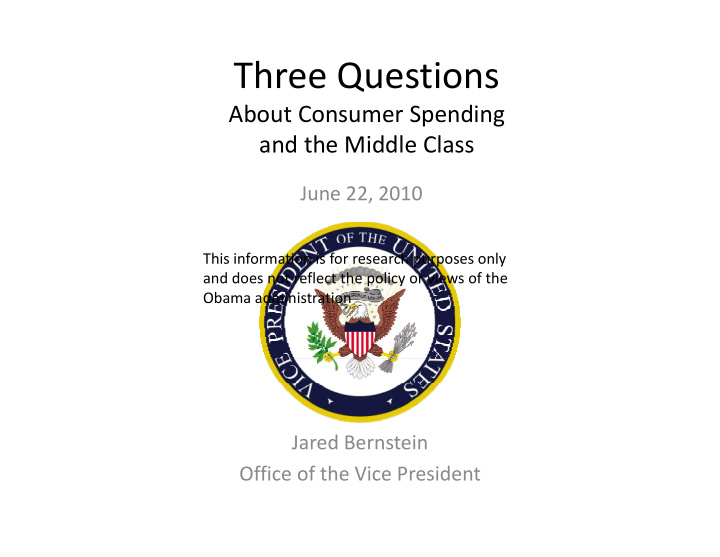



Three Questions About Consumer Spending and the Middle Class June 22, 2010 This information is for research purposes only and does not reflect the policy or views of the Obama administration Jared Bernstein Office of the Vice President
Disclaimer Disclaimer • This information is for research purposes only This information is for research purposes only and does not reflect the policy or views of the Obama administration Obama administration.
Three Questions: Three Questions: 1. How do we define the middle class, and how do we measure their progress? This calls for differentiating their measure their progress? This calls for differentiating their actual consumption (and saving) against a more prescriptive assessment. 2. 2. If we give up on prescription, we still should be interested If we give up on prescription, we still should be interested in relative consumption differences across income classes. What is the trend in consumption inequality (and how does it relate to income inequality)? q y) 3. Underlying both absolute and relative consumption challenges facing the middle class is the growing gap between productivity and compensation. A significant p y p g share of the growth in the gap (about a third) since 1979 is due to the difference in growth rates between product and consumer deflators. How can we better understand the implications of this divergence? h l f h d ?
Source: Department of Commerce, “Middle Class in America.” Underlying data from various sources.
Growth in Real Income and Consumption 8.0% by Income Quintile, 2000 ‐ 2007 Top Fifth Top Fifth 7.0% 6.0% 4 0% 4.0% 2000 ‐ 2007 2.0% ercent growth, 2 Middle Fifth 1.5% 0.0% Pe Middle Fifth Middle Fifth Top Fifth ‐ 1.7% ‐ 1.9% ‐ 2.0% ‐ 4.0% Bottom Fifth Bottom Fifth ‐ 5.2% ‐ 5.6% ‐ 6.0% Income Growth Consumption Growth Source: Current Expenditure Survey, CPS ASEC.
Decomposition of Wage ‐ Productivity Disparity, 1979 ‐ 2009 200% Productivity 180% Change in Factor Shares Real Average Compensation, Implicit Price Deflator 160% m 1979 CPI/IPD Difference ent change from Real Average Compensation 140% Productivity Average/Non ‐ Manager Difference Perce Real Non ‐ Managerial 120% Compensation Wage/Compensation Difference Real Non ‐ Managerial Wages 100% Real Non ‐ Managerial Wages 80% 1979 1982 1985 1988 1991 1994 1997 2000 2003 2006 2009 Source: Bureau of Labor Statistics.
Source: Bureau of Labor Statistics. Annualized r ate of growth du uring time perio od 0% 1% 2% 3% 4% 5% 6% 3.6% 1973 ‐ 2009 Imp plicit Price Defla tor Consumer Prices Outpace Product Deflators 4.1% CPI ‐ ‐ U ‐ RS 4 5% 4.5% Imp plicit Price Defla tor 1979 ‐ 89 5.1% CPI ‐ ‐ U ‐ RS 2.0% 1989 ‐ 2000 Imp plicit Price Defla tor 2.7% CPI ‐ ‐ U ‐ RS 2.2% Imp plicit Price Defla tor 2000 ‐ 07 2.7% CPI ‐ ‐ U ‐ RS
Recommend
More recommend